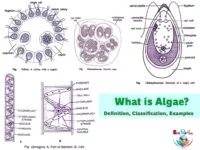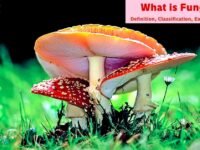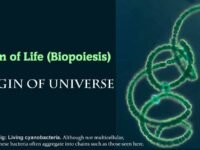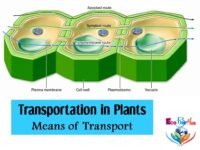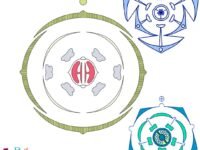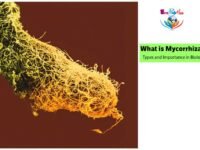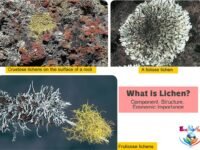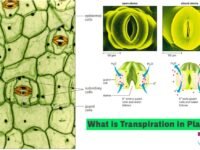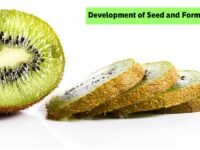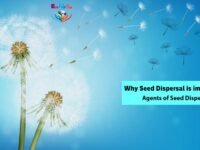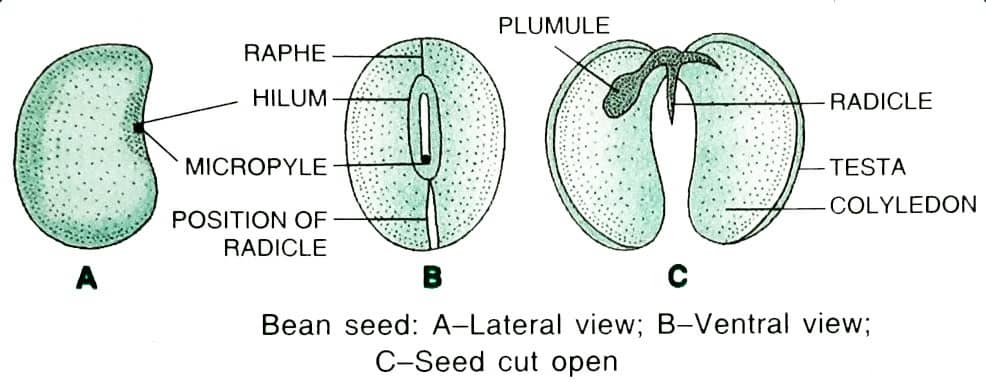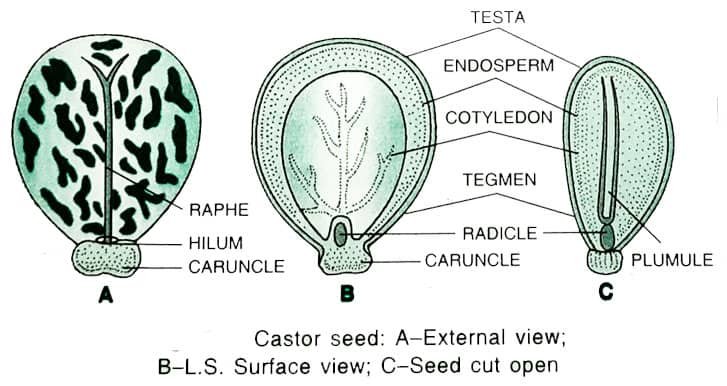In this tutorial, we have discussed development of seed and formation of fruit and their biological significance.
TABLE OF CONTENTS
Development of Seed
Fertilisation induces the following changes during the development of ovule into seed:
1. Zygote develops into embryo.
2. Triploid primary endosperm nucleus gives rise to nutritive endosperm. The endosperm provides nourishment to the developing embryo.
3. Nucellus is used up during the development of an embryo, but in some cases, it persists as a thin layer, called perisperm.
4. The two integuments of the ovule dry up. The outer integument becomes hard and forms testa, while the inner one forms membranous tegmen.
5. Micropyle remains in the form of a fine pore on the surface of the seed. Oxygen and water enter the seed through this pore at the time of germination.
6. Hilum marks the point of attachment of the ovule to stalk. Funicle is transformed into the stalk of the seed.
Seeds of most plants germinate when they are provided suitable conditions of temperature, oxygen, and moisture. However, seeds of many plants do not germinate immediately even when they get all favourable conditions. Germination of such seeds may be delayed by days, weeks, months, or even years. Such seeds are said to be in a state of dormancy. Thus, dormancy is that phase in the life cycle of seed, when it fails to germinate even though the environmental conditions which are normally considered favourable are present.
► Dicotyledonous and Monocotyledonous Seeds On the basis of the number of cotyledons present, seeds may be dicotyledonous or monocotyledonous. The dicotyledonous seeds have two cotyledons, e.g., Bean, Pea, Gram, Castor, etc., while monocotyledonous seeds have only one cotyledon, e.g., Rice, Wheat, Maize, etc. ► Albuminous and Exalbuminous Seeds In albuminous (endospermic) seeds, endosperm persists in the seed as food storage tissue as in Castor, Wheat, Barley, Maize and Coconut. In exalbuminous seeds, endosperm is completely used up by the growing embryo. Food for further development of embryo during germination is stored in cotyledons. Such seeds are also called non-endospermic seeds, e.g., Gram, Bean, Pea, and Groundnut.
► Read More: Different Types of Fruits in Biology & its Importance ► Read More: Why Seed Dispersal is important? Agents of Seed Dispersal ► Read More: What is Pollination? Definition, Types, Agents, Significance ► Read More: Reproduction in Plants : Sexual and Asexual reproduction ► Read More: Stem Anatomy || Monocot and Dicot Stem Cross Section || ► Read More: Inflorescence Types || Racemose, Cymose, Mixed, Specialized
Structure of Seeds
■ Structure of Dicotyledonous Seeds
1. Structure of Bean Seed
It is a dicotyledonous and exalbuminous seed. It is kidneyshaped and brown. Its concave side is darker in colour with a whitish scar or hilum. Micropyle lies at one end of hilum. Raphe lies at the opposite end. Close to the hilum is a bulge indicating the underlying radicle. The seed is covered by a thick tough seed coat called testa. Within the testa is a thin transparent tegmen. The embryo has a curved axis or tigellum.
Two massive cotyledons arise from the middle of the embryo axis. Lying between the cotyledons at one end of the embryo axis is the plumule, the future shoot. It has two small folded leaves. The part of embryo axis between cotyledonary node and plumule is called epicotyl. The other end of the embryo axis protruding partially from cotyledons is radicle, the future root. The part of the axis between the radicle and cotyledonary node is called the hypocotyl.
2. Structure of Castor Seed
It is a dicotyledonous albuminous seed. The seed is oblong in outline with a mottled brown shining surface.
The proximal narrow end bears a bilobed white spongy caruncle. Hilum and micropyle are located below the caruncle. Raphe runs ventrally from hilum. Seed is covered by a thick, hard, brittle testa and a thin tegmen.
Endosperm is a fleshy and oily food-storing tissue that lies inside the seed coat. Embryo lies centrally. The embryonal axis or tigellum is short with two papery whitish cotyledons, a knob-like radicle, and a small plumule.
■ Structure of Monocotyledonous Seeds
1. Structure of Onion Seed
It is a monocotyledonous albuminous seed. It is small, wrinkled and black in colour. A tough seed coat is present on the outer side. Internal to it is a tough semi-transparent endosperm. The embryo has a large scutellum (cotyledon). It is differentiated from the embryo axis by a notch. The radicle lies on the other side. Hypocotyl is present but plumule is not distinct. Instead, a shoot apical meristem is present close to the notch from where the cotyledon grows and the plumule develops later.
2. Structure of Maize Grain
Maize seed is called grain because its fruit wall (pericarp) is fused with the seed coat (testa). It is described as monocotyledonous, albuminous, single-seeded fruit is called caryopsis.
A maize grain is more or less oblong. Its flat upper surface has a light coloured depression which marks the position of embryo within. Each maize grain has the following parts:
(a) Seed Coat: It is an outer hard covering, formed by the fusion of pericarp and seed coat. It is yellowish-brown in colour.
(b) Endosperm: It is the major part of grain with stored food. It is differentiated into an outer aleurone layer made up of aleurone proteins and inner endosperm rich in starch. Endosperm is separated from the embryo by epithelial layer.
(c) Embryo: It is differentiated into scutellum and embryonal axis.
(i) Scutellum is a shield-shaped single cotyledon. It does not store food but serves to transfer food from endosperm to growing embryo during germination.
(ii) Embryonal axis is differentiated into upper plumule and lower radicle. The root cap protects the tip of radicle and is covered with a protective sheath called coleorhiza. The plumule with a number of young leaves is ensheathed by coleoptile.
The region between the cotyledonary node and the base of coleoptile is called the mesocotyl. It is the first internode.
TABLE: Differences between Perisperm and Pericarp
Sl. No.
Perisperm
Pericarp
01.
Perisperm is a part of the seed.
Pericarp is a part of the fruit.
02.
It represents the remains of nucellus.
It represents the ovarian wall.
03.
It is usually dry.
It may be dry or fleshy.
04.
It has no functional importance.
It takes part in protection, dispersal, and nutrition.
TABLE: Differences between Integument and Testa
Sl. No.
Integument
Testa
01.
It forms the covering of the ovule.
It forms the covering of the seed called the seed coat.
02.
It consists of thin-walled cells.
It consists of thick-walled cells.
03.
Its cells are living.
Its cells are nonliving.
04.
Integument is thin.
Testa is quite thick.
Seed Viability
Seed viability varies in different kinds of seeds. In a few species, seeds lose their viability within a few months. But seeds of a large number of plants live for several years and certain seeds can remain alive for hundreds of years. The seeds of Lupine, Lupinus arcticus, were excavated from Arctic Tundra. When sown, these seeds germinated and flowered after remaining in dormancy for 10,000 years. Recently, about 2,000 year-old viable seeds of the Date Palm, Phoenix dactylifera, were excavated from King Herod’s palace near the Dead Sea.
Significance of Seed Formation
1. Dependable Process: In gymnosperms and angiosperms, pollination and fertilisation are not dependent on water, hence seed formation is a more dependable process. It is because it ensures better chances for the formation of seeds and hence better chances for race multiplication.
2. Perennation: Seed enables the future plant to pass through unfavourable periods due to: (a) tough covering, (b) dormant embryo, (c) dehydrated protoplasm and (d) inactive enzymes.
3. Dispersal: Seeds have adaptive strategies for dispersal to different habitats. These strategies help the species colonise new areas.
4. Reserve Food: Seeds have enough reserve food to nourish the young seedlings till they start synthesising their food.
5. Food Source: Seeds are a major source of the human diet and are of economic value. They provide us oils, fibres, spices, beverages, etc. Moreover, seeds can be stored for a long period, i.e., over a year. Therefore, seeds form a regular supply of food even during drought conditions.
6. Variations: Seeds are formed as a result of sexual reproduction. Due to crossing over and new genetic combinations, seeds have a number of variations. Variations make the seeds adaptable to new environmental conditions.
7. Agriculture: Seeds are the basis of agriculture. Discovery of the edible nature of some seeds by early man led to agriculture and human evolution.
It is seen that all the flowers borne on a plant do not mature into fruits. In Apple and Mango, for example, fruit formation is extremely low as compared to the total number of flowers formed. The shedding of flowers may occur before or after anthesis (Period from flowering to fruit setting). This is called flower thinning. In certain cases, even immature fruits may drop. This is called dune drop. Application of auxins has been found useful in controlling flower thinning and dune drop. However, dropping of flowers and young fruits is of much significance to the cultivators because it results in the production of fruits of larger size. In Apples, Pears, and Plums, flower thinning by hormonal spray is a regular practice.
Formation of Fruit
Fertilisation provides stimulus for the ovules to mature into seeds and ovary into fruit. The two events occur simultaneously. Usually, all the parts of a flower except the ovary wither away. The ovary begins to enlarge with the development of seeds and changes into the fruit.
TABLE: Events Leading to the Formation of Fruit and Seeds in Flower
| Floral Parts (before fertilisation) | Changes in Floral Parts (after fertilisation) |
| 1. Sepals | 1. Fall off but may persist in some cases |
| 2. Petals |
2. Fall off |
| 3. Stamens | 3. Fall off after dehiscence of anthers |
| 4. Stigma and style | 4. Fall off |
| 5. Ovary | 5. Fruit |
| 6. Ovary wall | 6. Pericarp |
| 7. Ovule
(a) Funicle (b) Hilum (c) Nucellus (d) Micropyle (e) Outer Integument (f) Inner integument (g) Embryo Sac (i) Egg cell (ii) Secondary nucleus (iii) Synergids and antipodal cells |
7. Seed
(a) Changes into stalk of seed (b) Hilum (c) Changes into perisperm (d) Micropyle (e) Changes into testa (f) Changes into tegmen (g) Changes into embryo and Endosperm (i) Changes into embryo (ii) Changes into endosperm (iii) Degenerate |
Structure of Fruit
A fruit has a wall or pericarp which develops from the wall of the ovary. When well developed, it shows three layers – outer epicarp, middle mesocarp, and inner endocarp.
In Mango and Coconut, the fruit is known as a drupe. It develops from monocarpellary superior ovary and is one-seeded. In Mango the pericarp is well differentiated into an outer thin epicarp, a middle fleshy edible mesocarp, and an inner stony-hard endocarp. In Coconut which is also a drupe, the mesocarp is fibrous.
TABLE: Comparison between True and False Fruits Examples: Pea, Mango, etc. Examples: Apple, Pear, Strawberry.
True Fruit
False Fruit
Only ovary takes part in the formation of fruit.
In false fruits, along with ovary some other floral parts participate in the formation of fruit.
A true fruit or eucarp is one which develops from a single, superior ovary of a single flower with no other floral part outside the ovary, e.g., Mango. A false or spurious (pseudocarp) fruit develops from the interior ovary and other floral parts also take part in the formation of fruit. All aggregate and multiple fruits are false fruits. Fruits of Apple and Pear are false fruits as the edible part is mainly fleshy thalamus. Brinjal is false fruit as it has persistent calyx. Likewise, strawberries and Fig are also false fruits. Parthenocarpic fruits are seedless fruits, They develop from the ovary without fertilisation, e.g., Banana, Seedless Grapes.
Role of Seed & Pollination in Fruit Development
■ Role of Seed in Fruit Development
It has been proved experimentally that pollen contains only a small amount of auxin. This auxin together with auxins present in the carpellary tissues, can support only limited growth of the ovary. Further growth of the ovary into fruit depends on the development of normal seeds which synthesise auxins, gibberellins, and cytokinins. Thus, seeds play a key role in fruit development. In the absence of seeds, fruits can be developed by applying a small amount of auxins. Nitsch performed several experiments on strawberries to demonstrate the importance of seeds in fruit development.
The role of seeds in fruit development could also be demonstrated by selective pollination of some carpels because unpollinated carpels do not form seeds. However, normal fruit development could be induced even after removing the carpels by applying small amounts of auxin.
The development of fruit involves both cell division and cell expansion. After fertilisation, the ovary shows rapid growth. In Pumpkin, the ovary increases 20 fold in about 2 weeks time.
■ Role of Pollination in Fruit Development
Pollination is essential for fertilisation of ovule, formation of seed, development of fruit, and prevention of ovary abscission and fall of mature ovary because:
1. Pollination ensures the transfer of pollen (male gametes) to the stigma of gynoecium.
2. Proteins and other components present in the wall of pollen grains help in the recognition of pollen as self and stimulate secretion of auxins (specific hormones) from both pollen and carpel.
3. Auxins stimulate the initial growth of the ovary to form fruit.
4. Pollination ensures the union of male and female gametes (fertilisation) and seed formation.
Biological Significance of Fruit Formation
Fruits are in use since prehistoric times as the main food of man. Even today fruits comprise the main part of the human diet. But fruit formation has its own significance for the plant:
1. Fruit protects immature seeds from unfavourable environmental conditions. The seeds remain enclosed in the fruit until they are ready to germinate.
2. The fruit wall also helps in seed protection because of its colour. When young, most fruits are green, and remain hidden in the foliage.
3. The immature fruits offer a chemical defense against the animals because they contain unpalatable and repelling substances like astringents, tannins, sour acids, and bitter alkaloids.
4. Mature fruits acquire bright colours to attract the seed dispersing animals.
5. Certain fruits on maturity burst with great pressure so that the seeds are dispersed to a distance.
Ripening of Fruit
Fruit ripening is the last event in development of the fruit. As soon as growth of the ovary wall due to cell division and cell enlargement ceases, the fruit is said to be mature. This is followed by fruit ripening. This stage is characterised by the conversion of starch into sugar, reduction in the concentration of acids, and the production of esters.
The breakdown of chlorophyll leads to changes in colour, texture, taste and flavour of the fruit. A mature fruit of Mango is hard and green with its edible portion being white and sour. On ripening, the mesocarp becomes yellow-orange, juicy and sweet. In certain fruits like Banana, ripening is characterised by an increase in the respiratory rate. This is known as climacteric. This is followed by decaying which leads to death.


